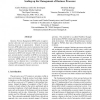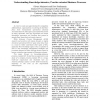WCRE
2008
IEEE
14 years 8 months ago
2008
IEEE
A business application automates a collection of business processes. A business process describes how a set of logically related tasks are executed, ordered and managed by followi...
TASE
2008
IEEE
14 years 8 months ago
2008
IEEE
The WS-BPEL language has recently become a de facto standard for modeling Web-based business processes. One of its essential features is the fully programmable compensation mechan...
SEMCO
2008
IEEE
14 years 8 months ago
2008
IEEE
Business Process Management (BPM) aims at supporting the whole life-cycle necessary to deploy and maintain business processes in organisations. Despite its success however, BPM su...
ICSEA
2008
IEEE
14 years 8 months ago
2008
IEEE
In order to increase efficiency, enterprises support their business processes by information technology (IT). The majority of business processes requires human interaction. By mea...
HICSS
2008
IEEE
14 years 8 months ago
2008
IEEE
In order to create new opportunities for competitive differentiation, organisations are starting to shift their focus from transactional operational Business Processes (BPs) to ot...
HICSS
2008
IEEE
14 years 8 months ago
2008
IEEE
Many business processes are relying on a smooth and flexible IT support. A major finding of IS research is that in order to generate value from IT the complementarities between IT...
HICSS
2008
IEEE
14 years 8 months ago
2008
IEEE
Enterprise architecting is becoming critical for most modern organizations whose competitive strategies are tightly linked to the underlying information technology (IT) infrastruc...
HICSS
2008
IEEE
14 years 8 months ago
2008
IEEE
An increasing level of cooperation between public administrations nowadays on national, regional and local level requires methods to develop interoperable EGovernment systems and ...
SEMWEB
2009
Springer
14 years 9 months ago
2009
Springer
Enriching business process models with semantic annotations taken from an ontology has become a crucial necessity both in service provisioning, integration and composition, and in ...
RE
2009
Springer
14 years 9 months ago
2009
Springer
Service-oriented architectures (SOA) aim at the alignment of business and IT by having a clear business process-centric focus. In order to reach that goal, real-world business pro...







